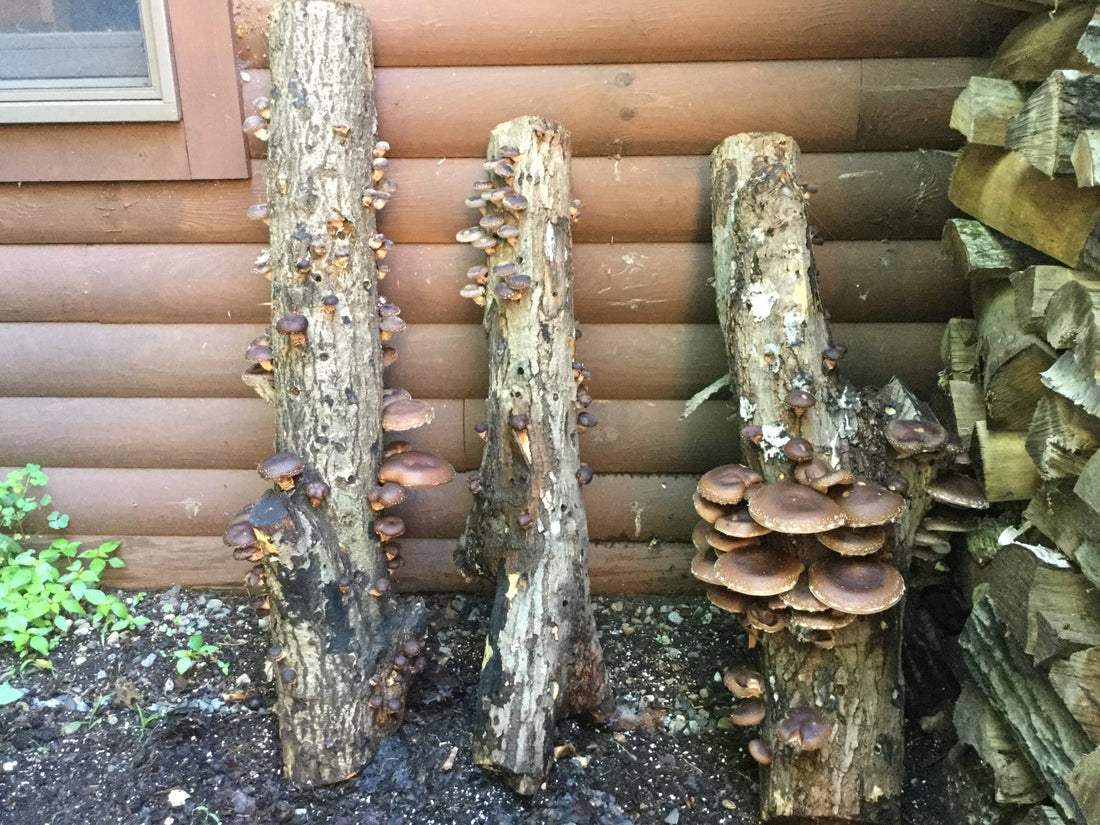Below is a step-by-step process for how to grow mushrooms outside, featuring the process of growing mushrooms ON LOGS. Make your own shiitake mushroom log!
There are many different ways to grow mushrooms outside including in woodchip beds, on totems, stumps, or fruiting sawdust blocks or straw logs outside. The most common method of growing mushrooms outside is on hardwood logs. Growing mushrooms on logs as a method of cultivation is one of the first methods discovered and was perfected in Japan over the last 800 years. Log cultivation is slow but requires little start up capital and maintenance. When starting mushroom cultivation, log cultivation is a great method to learn how to grow mushrooms outside. If you would like to learn how to grow mushrooms outside with wine caps visit this post.

Several important tips for successfully growing mushrooms on logs
- Tree species and timing for inoculation. Shiitake evolved growing on a tree in the genus Quercus, which is the same as the oak species in North America. Typically the best yields are achieved when shiitakes are grown on oak logs, other species that do well are sugar maple, beech, ironwood, and musclewood. Yields are also typically best when inoculation occurs in the spring from late march to early may. Fall inoculations can do very well especially if a greenhouse is available for incubation during several of the winter months.
- Cutting and handling logs. Ideally logs should be cut between December and March. If the logs are going to be stored in the winter before inoculation they should be placed in a well-shaded area out of any wind. Stacks should be kept close to the ground and tarped. Snow cover can be a great way to keep moisture inside the log. If logs are cut outside of the dormant season they should be inoculated as soon as possible. Logs should have minimal bark damage and be free of rot or other visible fungi on them.
- Spawn and strain selection for growing mushrooms on logs. The selection of a quality spawn producer and the correct strain is vital to the success of growing mushrooms outside. The best producer for shiitake mushrooms is LE46 a wide range shiitake strain that responds to shocking and has a fast spawn run.
- Managing logs after inoculation for growing mushrooms on logs. Moisture is critical to growing mushrooms. The moisture content of logs should be maintained around 45%. Mycelium can grow anywhere between 20-50%, but outside of that range will be suffocated by water or killed through drought. The most important time to maintain proper moisture content is during the first year spawn run. If rainfall does not occur every 2 weeks be sure to water your logs. You can do this by placing a sprinkler on them for 4-8 hours or by soaking them for 2-5 hours. This will bring the moisture content back up and keep the logs happy for another month.
Step-by-step process: How to grow mushrooms outside with log cultivation
- Cut logs and gather materials. The first step to growing mushrooms on logs is to gather all materials you will need for growing mushrooms outside. Order sawdust or plug spawn here. If you are using sawdust spawn, you will also need to purchase a palm inoculation tool. If you are using plug spawn you will need a hammer. Cut the logs being used for cultivation between December and March.

- Drill holes into the log for the spawn to go into. The holes should be about 1 inch deep and spaced 6 inches apart in the row. The log should be rotated 2 inches to start the next row, drill all the way around the surface of the log with 2 inches in between rows and 6 inches in between holes in the row. The rows can be off set creating a diamond pattern.
- Fill the holes with either plug or sawdust spawn. If using the plug spawn place each dowel on the hole and hammer it in until it is flush with the surface of the log. If using sawdust spawn, fill the palm inoculator with spawn to create a dowel-like structure and then hit the inoculator to place it into the hole. Be sure the hole is completely filled with sawdust spawn. Sometimes it can look like it is full but really there is only a small amount of sawdust spawn inside. You can use a small stick or allen wrench to ensure the sawdust spawn is fully compacted.
- Once the holes have been drilled and filled the last step is to wax over the holes. This ensures the sawdust spawn has a moist and safe place to grow. The bark of the log acts as an armor, keeping unwanted fungi out and moisture in. By waxing over the inoculation holes the sawdust spawn will not dry out as it grows into the log. Other fungi with spores floating around in the air will also not be able to get into the log to compete with the shiitake mycelium.

- Lastly, stack the logs in a shaded area. Conifer works best for the year-long incubation of logs. Logs that are inoculated in April will begin their fruiting period the following June. Be sure to maintain moisture around 45% during the incubation period. It is critical to water the logs every 2-3 weeks if there is no rainfall. To water, either soak for 4-5 hours (although this can be very labor intensive) or place a sprinkler on for 4-8 hours.

